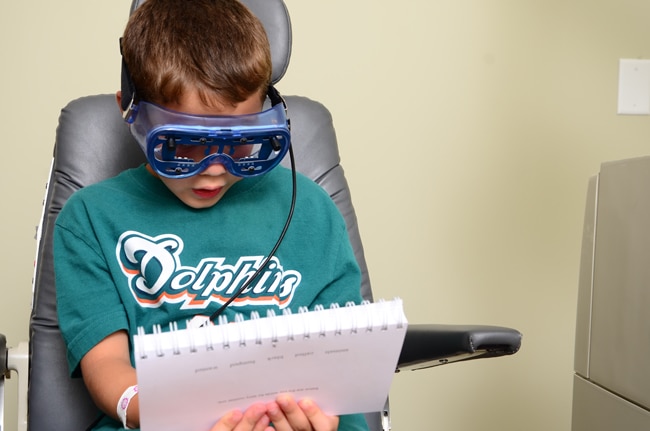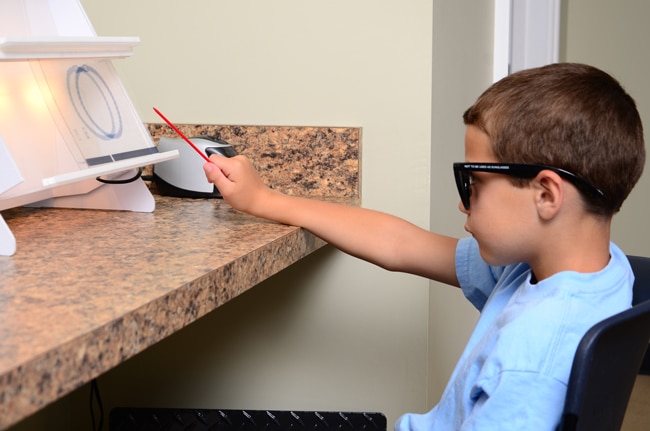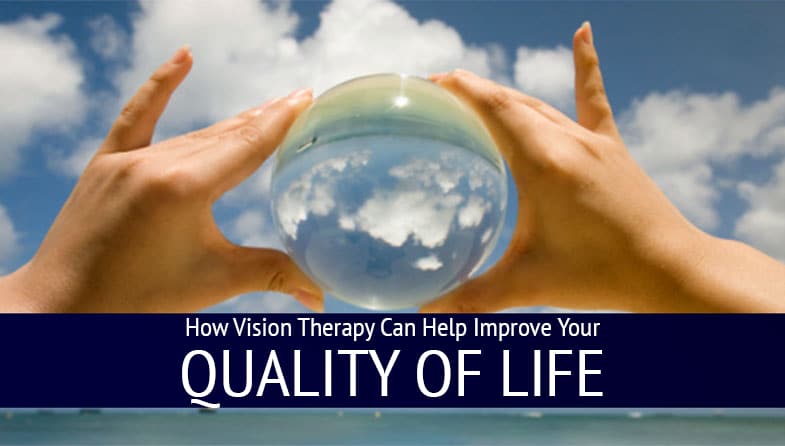20/20 vision is NOT perfect vision.
When you can’t see properly, your options are limited in a number of frustrating ways. There are limits on what you can do for a living, and a multitude of challenges you’ll face when it comes to simply navigating your way through life. However, many people fail to realize that 20/20 vision is NOT perfect vision. In fact, it’s all too common for adults and children alike to have 20/20 vision, but still have trouble with tracking, depth perception, and focusing.
In cases like these, the problem may very well not be with the eyes’ ability to see properly. It may instead indicate an issue with the brain’s ability to properly process information received via the eyes or with the ability of the eyes to work together properly with one another. Glasses are designed to correct and compensate vision that is less than 20/20, but they won’t help with issues like these.
That’s where vision therapy comes in. Vision therapy evaluations pick up where routine eye exams leave off by determining the true reasons for vision issues despite having 20/20 vision. Vision therapy is not about surgery, glasses, or corrective contact lenses. It’s the next logical step for those that have trouble seeing, but have been told there’s nothing wrong because their vision is considered to be 20/20. It’s not all in your head, and vision therapy can help.
What Is Vision Therapy and What Can It Accomplish?
Vision therapy as an umbrella term refers to a customized, non-surgical program consisting of visual activities that can help strengthen visual skills or correct certain visual issues altogether. It has quite a lot in common with physical therapy. In much the same way that physical therapy can help improve one’s physical function and help restore it to normal, vision therapy can do the same for the eyes and their functionality. It aims to “teach” the brain and eyes to work together optimally while glasses or contacts are usually prescribed to compensate for vision issues.
Activities that may be included in a vision therapy program can include (but not limited to):
Computerized Visual Activities
Use of Lenses or Prisms
Exercises Through Rhythm and Music
However, it’s important to understand that vision therapy cannot be properly defined with a simple list or a standardized set of tools and practices.The overall goal of a given treatment is to treat and rehabilitate in instances where corrective lenses and/or surgery alone are not the key to achieve comfortable, healthy, successful binocular vision. Vision therapy has been found effective at helping schoolchildren read, write, learn, and achieve. It can help people of all ages recover from vision problems related to concussion, brain damage, or injury, as well. It can frequently help in the relief of eye strain, computer vision fatigue, and many more common problems. It can also help athletes achieve a high level success!



Why is Vision Therapy So Effective?
For some people, the very idea of vision therapy goes against everything they think they understand about why people have trouble seeing and what can be done about it. As touched on above, such people tend to think that treatment starts and stops at glasses, contact lenses, or corrective surgery. However, they also fail to understand how our brains work.
The Brain Plays a Huge Roll
For some people, the very idea of vision therapy goes against everything they think they understand about why people have trouble seeing and what can be done about it. As touched on above, such people tend to think that treatment starts and stops at glasses, contact lenses, or corrective surgery. However, they also fail to understand how our brains work.
Everyone has heard the saying that claims “you can’t teach an old dog new tricks.” However, any neurologist can tell you that this isn’t necessarily the case when it comes to the human brain. No, it isn’t an easy or simple thing to accomplish, but it’s definitely something that can be done.
The brain comes attached to a high degree of neuroplasticity. Neuroplasticity refers to the brain’s ability to change both in structure and function in response to the right external stimuli. At one point, neuroplasticity was considered to be a quality only found in the brains of very young children. However, we now know that this isn’t true. There is quite a bit of evidence to suggest the brains of older children and adults still very much possess this quality.
When a given person has 20/20 vision, but still has vision problems, it’s possible that their brain and eyes need to relearn how to work together properly.
Consider, for example, a study conducted using adult typists that were given extended training to help improve their cognitive skills, typing speed, and keyboard agility. They didn’t just learn to be better, faster, and more efficient typists. Their brains also showed a considerable increase in the development of gray matter – this shows that the learning process doesn’t just change the function of the mind, but the form as well. This is an example of neuroplasticity at work, and demonstrates that it isn’t just an ability our brains possess when we’re children.
When a given person has 20/20 vision, but still has vision problems, it’s possible that their brain and eyes need to relearn how to work together properly. That’s where vision therapy comes in, by tapping into the brain’s natural penchant for neuroplasticity and teaching it a few new tricks when it comes to how to process the information received from the eyes.
Could Your Child Need Vision Therapy?
A child’s world almost always makes sense to him or her. That said, a given boy or girl only knows what the world looks like to them from the inside looking out. They most likely have no real idea what the experience of seeing is “supposed” to be like.So, you can’t count on a child to know on their own when there’s a problem and report it to you. It helps to know how to read the possible signs.
Vision problems in children can also cause teachers or parents to suspect learning disabilities. If your child has a reputation for being lazy, for having a “behavioral problem,” or for being a slow learner, but you don’t feel that assessment fits the child you know, then it might be a good idea to have their vision evaluated. The same goes for children who have unexplained problems writing, trouble completing/turning in assignments on time, or issues with assignments taking longer than they should.
Children who are slow to learn to read or who read at a “below average” ability for their age could very well be suffering from vision problems. If it seems like your child has a lot of trouble with reading comprehension, or has a tendency to skip small words and/or skip lines when reading aloud, then it’s certainly a possibility.
Many children with vision problems can also display trouble paying attention while reading. They may appear to become tired during the reading process, or seem to be avoiding activities that require them to read or perform other “close work,” either in school or at home.
Problems seeing properly can absolutely cause other physical symptoms or discomfort. Does your child complain of headaches when reading, doing homework, or after putting in a full day at school? Are they unusually clumsy or prone to knocking over objects? Do they appear to misjudge distances on a regular basis? Do they get carsick as a rule? Do they have trouble with sports or P.E.? If so, then a vision problem could well be a factor.
If you suspect that a vision problem could potentially be an issue for your child, watch for other signs that could confirm your suspicions. Many children with vision issues will tilt their head or close one eye when attempting to read or see objects from far away. They may also rub their eyes, complain that their eyes burn, or squint excessively.
Remember that your child may not be able to identify a problem or know that they should come to you about it if they suspect one. The sooner you bring him or her in for a vision evaluation, the sooner you can determine whether or not assistance or treatment is needed. The sooner an issue is identified and dealt with, the more your child will be able to make of their education and future.
Keep in mind that thorough evaluation of a child’s vision doesn’t start and stop at a routine eye exam at school or at the pediatrician’s office. If your child has been found to have 20/20 vision via a routine exam, or they already wear corrective lenses, but they still show evidence of having vision trouble, vision therapy may be able to help. Consider bringing him or her in for a full vision evaluation at Vision Care and Therapy Center, sooner rather than later. The sooner the child is evaluated, the sooner the two of you can start working together to correct the problem.
What Issues Can Vision Therapy Help Correct?
Not every issue can be corrected merely by wearing glasses or contacts. If you or your child, suffers from any of the following, then vision therapy may well be an option that’s worth exploring.
Amblyopia
Amblyopia is commonly referred to as a “lazy eye.” If one of your eyes can’t quite maintain a normal level of visual acuity, then you might be able to benefit from vision therapy.
Strabismus
Some people have issues with keeping their eyes in proper alignment with one another while they’re reading or processing information. This condition is known as strabismus.
Phorias
Phorias are subtle but very real issues with eye alignment that can interfere with the eyes’ naturally tendency to turn when needed. Phorias have been found to be the cause of many issues with eye strain, reading fatigue, and other similar issues. Vision therapy can help.
Injury-Related Vision Issues.
Injury-Related Vision Issues
Vision therapy can even help those suffering from vision problems related to stroke, injury, or other conditions. The same can be said for vision problems related to developmental disorders.
All things considered, vision therapy can accomplish a lot. It’s not a “magic” solution that will allow you to throw out your glasses or say good-bye to your contacts. It’s also not an ironclad guarantee that you’ll be able to experience perfect vision simply by doing a few exercises under the supervision of a doctor.
Exploring Viable Vision Therapy Options
If you or your child have been experiencing any of the issues detailed above, but you also know that you have 20/20 vision, the first order of business is to arrange for a developmental or functional eye exam. Dr. Iyer, a doctor that specializes in evaluating for vision therapy will check for issues including visual information processing, eye teaming, focusing, and more.
Be sure to check with your insurance company as to whether or not vision therapy is a treatment covered by your policy. (In many cases, it will be.) We will discuss the criteria surrounding a “successful” treatment so that you can better weigh the costs versus the benefits. Explore your options today!
CONTACT US
Vision Care & Therapy Center

Dr. Janna Iyer, FCOVD
Dr. Alayna Larsen
11735 Pointe Place
Roswell, Ga 30076
678-256-3990
Office Hours
Mon-Thu 9:00am-6:00pm
Fri 9:00am-1:00pm
Appointments
678-256-3990
Patient Infomation


